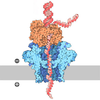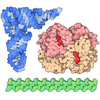[English] 日本語
 Yorodumi
Yorodumi- EMDB-45460: CryoEM Structure of Escherichia coli FimCH in complex with 2C07 Fab -
+ Open data
Open data
- Basic information
Basic information
| Entry |  | |||||||||||||||
|---|---|---|---|---|---|---|---|---|---|---|---|---|---|---|---|---|
| Title | CryoEM Structure of Escherichia coli FimCH in complex with 2C07 Fab | |||||||||||||||
 Map data Map data | ||||||||||||||||
 Sample Sample |
| |||||||||||||||
 Keywords Keywords | Adhesin / Inhibitor / complex / Fab / Chaperone / Usher / Pili / CELL ADHESION | |||||||||||||||
| Function / homology |  Function and homology information Function and homology information | |||||||||||||||
| Biological species |    | |||||||||||||||
| Method | single particle reconstruction / cryo EM / Resolution: 3.69 Å | |||||||||||||||
 Authors Authors | Lopatto EDB / Hultgren SJ | |||||||||||||||
| Funding support |  United States, 4 items United States, 4 items
| |||||||||||||||
 Citation Citation |  Journal: Sci Adv / Year: 2025 Journal: Sci Adv / Year: 2025Title: Monoclonal antibodies targeting the FimH adhesin protect against uropathogenic UTI. Authors: Edward D B Lopatto / Jesús M Santiago-Borges / Denise A Sanick / Sameer Kumar Malladi / Philippe N Azimzadeh / Morgan W Timm / Isabella F Fox / Aaron J Schmitz / Jackson S Turner / Shaza M ...Authors: Edward D B Lopatto / Jesús M Santiago-Borges / Denise A Sanick / Sameer Kumar Malladi / Philippe N Azimzadeh / Morgan W Timm / Isabella F Fox / Aaron J Schmitz / Jackson S Turner / Shaza M Sayed Ahmed / Lillian Ortinau / Nathaniel C Gualberto / Jerome S Pinkner / Karen W Dodson / Ali H Ellebedy / Andrew L Kau / Scott J Hultgren /  Abstract: As antimicrobial resistance increases, urinary tract infections (UTIs) are expected to pose an increased burden in morbidity and expense on the health care system, increasing the need for alternative ...As antimicrobial resistance increases, urinary tract infections (UTIs) are expected to pose an increased burden in morbidity and expense on the health care system, increasing the need for alternative antibiotic-sparing treatments. Most UTIs are caused by uropathogenic (UPEC), whereas causes a large portion of non-UPEC UTIs. Both bacteria express type 1 pili tipped with the mannose-binding FimH adhesin critical for UTI pathogenesis. We generated and biochemically characterized 33 murine monoclonal antibodies (mAbs) to FimH. Three mAbs protected mice from UTI. Mechanistically, we show that this protection is Fc independent and mediated by the ability of these mAbs to sterically block FimH function by recognizing a high-affinity FimH conformation. Our data reveal that FimH mAbs hold promise as an antibiotic-sparing treatment strategy. | |||||||||||||||
| History |
|
- Structure visualization
Structure visualization
| Supplemental images |
|---|
- Downloads & links
Downloads & links
-EMDB archive
| Map data |  emd_45460.map.gz emd_45460.map.gz | 57.3 MB |  EMDB map data format EMDB map data format | |
|---|---|---|---|---|
| Header (meta data) |  emd-45460-v30.xml emd-45460-v30.xml emd-45460.xml emd-45460.xml | 19.6 KB 19.6 KB | Display Display |  EMDB header EMDB header |
| FSC (resolution estimation) |  emd_45460_fsc.xml emd_45460_fsc.xml | 8.4 KB | Display |  FSC data file FSC data file |
| Images |  emd_45460.png emd_45460.png | 57.7 KB | ||
| Filedesc metadata |  emd-45460.cif.gz emd-45460.cif.gz | 6.4 KB | ||
| Others |  emd_45460_half_map_1.map.gz emd_45460_half_map_1.map.gz emd_45460_half_map_2.map.gz emd_45460_half_map_2.map.gz | 59.5 MB 59.5 MB | ||
| Archive directory |  http://ftp.pdbj.org/pub/emdb/structures/EMD-45460 http://ftp.pdbj.org/pub/emdb/structures/EMD-45460 ftp://ftp.pdbj.org/pub/emdb/structures/EMD-45460 ftp://ftp.pdbj.org/pub/emdb/structures/EMD-45460 | HTTPS FTP |
-Validation report
| Summary document |  emd_45460_validation.pdf.gz emd_45460_validation.pdf.gz | 586.8 KB | Display |  EMDB validaton report EMDB validaton report |
|---|---|---|---|---|
| Full document |  emd_45460_full_validation.pdf.gz emd_45460_full_validation.pdf.gz | 586.4 KB | Display | |
| Data in XML |  emd_45460_validation.xml.gz emd_45460_validation.xml.gz | 16 KB | Display | |
| Data in CIF |  emd_45460_validation.cif.gz emd_45460_validation.cif.gz | 20.8 KB | Display | |
| Arichive directory |  https://ftp.pdbj.org/pub/emdb/validation_reports/EMD-45460 https://ftp.pdbj.org/pub/emdb/validation_reports/EMD-45460 ftp://ftp.pdbj.org/pub/emdb/validation_reports/EMD-45460 ftp://ftp.pdbj.org/pub/emdb/validation_reports/EMD-45460 | HTTPS FTP |
-Related structure data
| Related structure data |  9ccwMC  9ccsC  9cctC  9ccuC M: atomic model generated by this map C: citing same article ( |
|---|---|
| Similar structure data | Similarity search - Function & homology  F&H Search F&H Search |
- Links
Links
| EMDB pages |  EMDB (EBI/PDBe) / EMDB (EBI/PDBe) /  EMDataResource EMDataResource |
|---|---|
| Related items in Molecule of the Month |
- Map
Map
| File |  Download / File: emd_45460.map.gz / Format: CCP4 / Size: 64 MB / Type: IMAGE STORED AS FLOATING POINT NUMBER (4 BYTES) Download / File: emd_45460.map.gz / Format: CCP4 / Size: 64 MB / Type: IMAGE STORED AS FLOATING POINT NUMBER (4 BYTES) | ||||||||||||||||||||||||||||||||||||
|---|---|---|---|---|---|---|---|---|---|---|---|---|---|---|---|---|---|---|---|---|---|---|---|---|---|---|---|---|---|---|---|---|---|---|---|---|---|
| Projections & slices | Image control
Images are generated by Spider. | ||||||||||||||||||||||||||||||||||||
| Voxel size | X=Y=Z: 1.184 Å | ||||||||||||||||||||||||||||||||||||
| Density |
| ||||||||||||||||||||||||||||||||||||
| Symmetry | Space group: 1 | ||||||||||||||||||||||||||||||||||||
| Details | EMDB XML:
|
-Supplemental data
-Half map: #2
| File | emd_45460_half_map_1.map | ||||||||||||
|---|---|---|---|---|---|---|---|---|---|---|---|---|---|
| Projections & Slices |
| ||||||||||||
| Density Histograms |
-Half map: #1
| File | emd_45460_half_map_2.map | ||||||||||||
|---|---|---|---|---|---|---|---|---|---|---|---|---|---|
| Projections & Slices |
| ||||||||||||
| Density Histograms |
- Sample components
Sample components
-Entire : Complex of FimCH with 2C07 Fab
| Entire | Name: Complex of FimCH with 2C07 Fab |
|---|---|
| Components |
|
-Supramolecule #1: Complex of FimCH with 2C07 Fab
| Supramolecule | Name: Complex of FimCH with 2C07 Fab / type: complex / ID: 1 / Parent: 0 / Macromolecule list: all |
|---|---|
| Source (natural) | Organism:  |
-Supramolecule #2: 2C07 Fab
| Supramolecule | Name: 2C07 Fab / type: organelle_or_cellular_component / ID: 2 / Parent: 1 / Macromolecule list: #2-#3 |
|---|---|
| Source (natural) | Organism:  |
-Supramolecule #3: FimH adhesin in complex with FimC chaperone
| Supramolecule | Name: FimH adhesin in complex with FimC chaperone / type: organelle_or_cellular_component / ID: 3 / Parent: 1 / Macromolecule list: #1 Details: FimH adhesin expressed in complex with FimC chaperone |
|---|---|
| Source (natural) | Organism:  |
-Macromolecule #1: Type 1 fimbiral adhesin FimH
| Macromolecule | Name: Type 1 fimbiral adhesin FimH / type: protein_or_peptide / ID: 1 / Number of copies: 1 / Enantiomer: LEVO |
|---|---|
| Source (natural) | Organism:  |
| Molecular weight | Theoretical: 29.03726 KDa |
| Recombinant expression | Organism:  |
| Sequence | String: FACKTANGTA IPIGGGSANV YVNLAPAVNV GQNLVVDLST QIFCHNDYPE TITDYVTLQR GAAYGGVLSS FSGTVKYNGS SYPFPTTSE TPRVVYNSRT DKPWPVALYL TPVSSAGGVA IKAGSLIAVL ILRQTNNYNS DDFQFVWNIY ANNDVVVPTG G CDVSARDV ...String: FACKTANGTA IPIGGGSANV YVNLAPAVNV GQNLVVDLST QIFCHNDYPE TITDYVTLQR GAAYGGVLSS FSGTVKYNGS SYPFPTTSE TPRVVYNSRT DKPWPVALYL TPVSSAGGVA IKAGSLIAVL ILRQTNNYNS DDFQFVWNIY ANNDVVVPTG G CDVSARDV TVTLPDYPGS VPIPLTVYCA KSQNLGYYLS GTTADAGNSI FTNTASFSPA QGVGVQLTRN GTIIPANNTV SL GAVGTSA VSLGLTANYA RTGGQVTAGN VQSIIGVTFV YQ UniProtKB: Type 1 fimbiral adhesin FimH |
-Macromolecule #2: 2C07 light chain
| Macromolecule | Name: 2C07 light chain / type: protein_or_peptide / ID: 2 / Number of copies: 1 / Enantiomer: LEVO |
|---|---|
| Source (natural) | Organism:  |
| Molecular weight | Theoretical: 23.907457 KDa |
| Recombinant expression | Organism:  Homo sapiens (human) Homo sapiens (human) |
| Sequence | String: TGVHSDIVMT QSQKFMSTSV GDRVSVTCKA SQNVVTNVAW YQQKSGQSPK VVIYSASFRS SGVPDRFTGS GSGTDFTLTI SNVQSEDLA EYFCHQYNSH PLTFGGGTKL EIKRTVAAPS VFIFPPSDEQ LKSGTASVVC LLNNFYPREA KVQWKVDNAL Q SGNSQESV ...String: TGVHSDIVMT QSQKFMSTSV GDRVSVTCKA SQNVVTNVAW YQQKSGQSPK VVIYSASFRS SGVPDRFTGS GSGTDFTLTI SNVQSEDLA EYFCHQYNSH PLTFGGGTKL EIKRTVAAPS VFIFPPSDEQ LKSGTASVVC LLNNFYPREA KVQWKVDNAL Q SGNSQESV TEQDSKDSTY SLSSTLTLSK ADYEKHKVYA CEVTHQGLSS PVTKSFNRGE C |
-Macromolecule #3: 2C07 heavy chain
| Macromolecule | Name: 2C07 heavy chain / type: protein_or_peptide / ID: 3 / Number of copies: 1 / Enantiomer: LEVO |
|---|---|
| Source (natural) | Organism:  |
| Molecular weight | Theoretical: 26.386527 KDa |
| Recombinant expression | Organism:  Homo sapiens (human) Homo sapiens (human) |
| Sequence | String: TGVHSEVKLV ESGEGLVKPG GSLKLSCAAS GFTFSSYAMS WVRQTPEKRL DWVAYISSGG DHIYYADTVK GRFTISRDNA RNTLYLQMS SLKSEDTAMY YCTRDTGYYV SRYFDVWGTG TTVTVSSAST KGPSVFPLAP SSKSTSGGTA ALGCLVKDYF P EPVTVSWN ...String: TGVHSEVKLV ESGEGLVKPG GSLKLSCAAS GFTFSSYAMS WVRQTPEKRL DWVAYISSGG DHIYYADTVK GRFTISRDNA RNTLYLQMS SLKSEDTAMY YCTRDTGYYV SRYFDVWGTG TTVTVSSAST KGPSVFPLAP SSKSTSGGTA ALGCLVKDYF P EPVTVSWN SGALTSGVHT FPAVLQSSGL YSLSSVVTVP SSSLGTQTYI CNVNHKPSNT KVDKKVEPKS CRSLVPRGSS GH HHHHH |
-Experimental details
-Structure determination
| Method | cryo EM |
|---|---|
 Processing Processing | single particle reconstruction |
| Aggregation state | particle |
- Sample preparation
Sample preparation
| Concentration | 0.15 mg/mL | |||||||||
|---|---|---|---|---|---|---|---|---|---|---|
| Buffer | pH: 7.5 Component:
| |||||||||
| Vitrification | Cryogen name: ETHANE |
- Electron microscopy
Electron microscopy
| Microscope | TFS GLACIOS |
|---|---|
| Image recording | Film or detector model: TFS FALCON 4i (4k x 4k) / Average electron dose: 54.6 e/Å2 |
| Electron beam | Acceleration voltage: 200 kV / Electron source:  FIELD EMISSION GUN FIELD EMISSION GUN |
| Electron optics | Illumination mode: SPOT SCAN / Imaging mode: BRIGHT FIELD / Nominal defocus max: 2.4 µm / Nominal defocus min: 1.0 µm |
 Movie
Movie Controller
Controller











 Z (Sec.)
Z (Sec.) Y (Row.)
Y (Row.) X (Col.)
X (Col.)





































